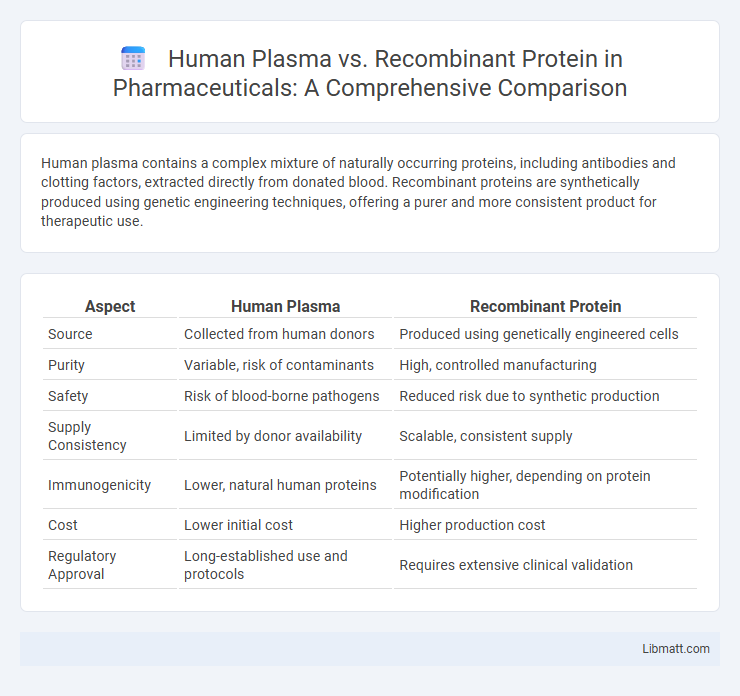Human plasma contains a complex mixture of naturally occurring proteins, including antibodies and clotting factors, extracted directly from donated blood. Recombinant proteins are synthetically produced using genetic engineering techniques, offering a purer and more consistent product for therapeutic use.
Table of Comparison
| Aspect | Human Plasma | Recombinant Protein |
|---|---|---|
| Source | Collected from human donors | Produced using genetically engineered cells |
| Purity | Variable, risk of contaminants | High, controlled manufacturing |
| Safety | Risk of blood-borne pathogens | Reduced risk due to synthetic production |
| Supply Consistency | Limited by donor availability | Scalable, consistent supply |
| Immunogenicity | Lower, natural human proteins | Potentially higher, depending on protein modification |
| Cost | Lower initial cost | Higher production cost |
| Regulatory Approval | Long-established use and protocols | Requires extensive clinical validation |
Introduction to Human Plasma and Recombinant Proteins
Human plasma, the liquid component of blood, contains a complex mixture of proteins crucial for clotting, immunity, and other physiological functions. Recombinant proteins are bioengineered molecules produced through genetic modification techniques, designed to replicate natural human proteins with high purity and consistency. These proteins provide targeted therapeutic benefits, reducing risks associated with blood-borne pathogens found in plasma-derived products.
Definition and Sources of Human Plasma Proteins
Human plasma proteins are naturally occurring molecules derived from donated blood plasma, essential for various physiological functions such as clotting and immune response. Recombinant proteins are artificially synthesized using genetically engineered cells, offering a controlled and pure alternative to plasma-derived proteins. Your choice between these sources depends on factors like safety, availability, and specific medical requirements.
Overview of Recombinant Protein Technology
Recombinant protein technology involves the insertion of specific human genes into host cells like bacteria, yeast, or mammalian cells to produce proteins identical to those found in human plasma. This method enables large-scale production of proteins such as insulin, clotting factors, and hormones with high purity and reduced risk of contamination compared to plasma-derived products. Advances in genetic engineering, fermentation, and purification techniques have significantly improved the yield, stability, and safety profile of recombinant therapeutic proteins.
Extraction and Production Processes
Human plasma extraction involves collecting blood from donors followed by fractionation to isolate specific proteins, ensuring biological activity and complex post-translational modifications are maintained. Recombinant protein production uses genetically engineered cells cultured in bioreactors to produce target proteins with high purity and scalability, though post-translational modifications may differ from native proteins. Your choice depends on the need for authentic protein structures versus the benefits of controlled, large-scale manufacturing.
Purity and Safety Considerations
Human plasma-derived proteins carry inherent risks of viral contamination despite rigorous screening and purification processes, whereas recombinant proteins are produced in controlled environments, significantly reducing the chance of pathogen transmission. Recombinant technology ensures higher purity levels by minimizing impurities and eliminating human blood-borne pathogens, making it a safer option for therapeutic use. Your choice between these two should weigh the importance of purity and safety tailored to clinical needs and potential immunogenic responses.
Therapeutic Applications and Uses
Human plasma-derived therapies are essential for treating bleeding disorders, immune deficiencies, and certain rare diseases by providing naturally occurring proteins like clotting factors and immunoglobulins. Recombinant proteins offer targeted therapeutic applications with enhanced safety profiles and consistent quality, widely used in hormone replacement, enzyme therapies, and monoclonal antibody treatments. Your choice between these options depends on factors like availability, risk of pathogen transmission, and the specific clinical condition being treated.
Immunogenicity and Allergic Reactions
Human plasma-derived proteins often carry a higher risk of immunogenicity and allergic reactions due to the presence of diverse human antibodies and proteins that may trigger immune responses. Recombinant proteins, produced through controlled genetic engineering processes, typically exhibit lower immunogenicity and reduced allergic reaction rates because they lack many of the impurities found in plasma-derived products. Your choice between these therapies should consider the balance between immunogenic safety and clinical efficacy to minimize adverse immune responses.
Cost and Scalability Comparison
Human plasma-derived proteins often incur higher production costs due to complex collection, screening, and processing requirements, limiting large-scale supply. Recombinant protein manufacturing benefits from scalable cell culture technologies, reducing per-unit costs and enabling rapid expansion to meet growing demand. Your choice between these sources should weigh the upfront costs against long-term scalability and market availability.
Regulatory and Ethical Aspects
Human plasma-derived products are subject to stringent regulatory standards to ensure safety, traceability, and donor consent, addressing risks such as pathogen transmission and ethical concerns regarding donor exploitation. Recombinant proteins benefit from controlled manufacturing processes that reduce contamination risks and ethical issues related to human donors, but they must adhere to regulatory guidelines ensuring consistent quality, efficacy, and biosafety. Your choice between human plasma and recombinant protein therapies involves balancing regulatory compliance with ethical considerations surrounding source materials and manufacturing practices.
Future Trends in Protein Therapeutics
Future trends in protein therapeutics emphasize a shift from traditional human plasma-derived proteins to recombinant protein technologies due to enhanced safety, scalability, and consistency in production. Advances in genetic engineering and bioprocessing enable the development of novel recombinant proteins with improved efficacy and reduced immunogenicity. Emerging innovations like synthetic biology and CRISPR gene editing are poised to revolutionize the design and manufacture of next-generation protein therapeutics.
Human plasma vs recombinant protein Infographic

 libmatt.com
libmatt.com